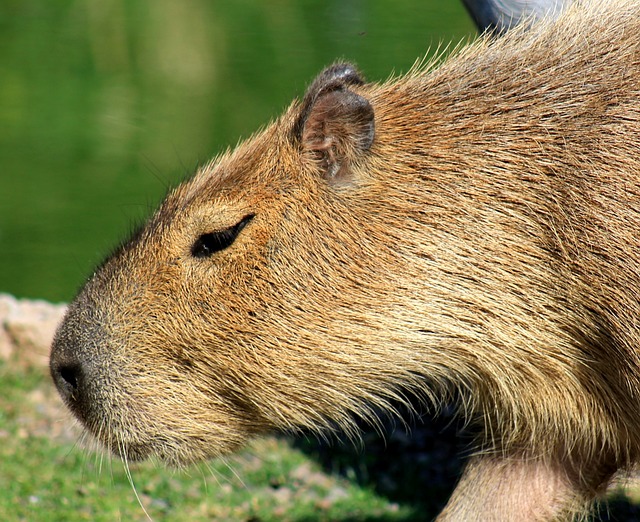Capybaras do not have the cognitive ability to understand and recognize human-given names in the same way that domesticated animals might.
Their communication and recognition abilities are more basic, and they respond to familiar sounds, voices, and physical cues from their human caregivers.
Training and Recognition
The ability of capybaras to respond to their names is closely linked to effective training methods and their natural social behaviors.
Recognition of names, much like in domesticated pets such as dogs, is possible through consistent association and positive reinforcement.
Name Recognition in Capybaras
Capybaras, due to their social nature, can learn to recognize the sound of their names. Training a capybara to recognize its name involves a process of conditioning where the animal starts associating the sound of its name with a positive stimulus, typically food.
There are observed instances where capybaras respond to their names being called by owners or caretakers, turning their heads or approaching the caller.
Training Techniques
Positive Reinforcement: This technique is crucial in capybara training and involves presenting a reward immediately after the capybara performs the desired action. For example:
| Action | Reward |
|---|---|
| Response to name | Treat or petting |
Consistency: Frequent, short training sessions enhance the capybara’s ability to associate its name with the expected response.
- Regular training intervals
- Use of the same clear, distinct name call
Patience: Training a capybara requires patience as these animals have their own pace of learning. Observing their individual personalities and adapting the training to fit their comfort levels yield better results.
- Observation of the capybara’s behavior
- Adjustment of training to individual learning speed
The Capybara
Capybaras, the largest rodents in the world, are known for their docile nature and ability to bond with various creatures, including humans.
This sociable behavior raises the question of whether capybaras can recognize and respond to their names when their caretakers call them.
Understanding animal cognition and their ability to process human language is a field of study that offers valuable insights into the interactions between different species, including the bonds formed between humans and pets.
Research into animal cognition suggests that many animals can recognize auditory cues associated with certain behaviors or outcomes.
In settings such as zoos or domestic environments where human-animal interaction is frequent, animals may come to associate specific sounds or words with positive reinforcement like food or social interaction.
Such conditioning could lead to a response from an animal when it hears its name, suggesting a level of recognition or awareness.
For capybaras, who live in groups and display complex social structures in the wild, the potential to recognize individual names raises interesting questions about their social intelligence and the extent to which they can communicate.
Observations and studies in controlled environments are valuable in determining the reality of name recognition in these creatures and shedding light on their cognitive abilities about human interaction.
Capybara Behavior and Communication
Capybaras exhibit complex social behaviors and have distinct ways of communicating with one another and with humans. Their responsiveness to human interaction and their vocal signals are crucial for understanding their social dynamics.
Response to Human Interaction
Capybaras can recognize and respond to their names when called by humans, a behavior often encouraged through positive reinforcement training.
Individuals that grow up in human care may develop a stronger response to specific people and can display behaviors such as following commands or coming when called, indicating a recognition of individual human caretakers.
Vocalizations and Social Cues
Vocal Communication: Capybaras communicate through various sounds such as barks, purrs, and whistles. Their vocalizations vary depending on the context, such as alerting the group of danger or signaling submission.
Non-vocal Communication: Social cues are also prevalent in capybara interactions. They establish social bonds through grooming and scent marking. Facial expressions, body posture, and direct physical contact communicate emotions and intentions within their group.
Cognitive Abilities of Capybaras
Capybaras demonstrate notable cognitive abilities, particularly in memory retention and social interactions which are crucial for their survival.
Memory and Learning Capacity
Capybaras have shown a capacity to remember and differentiate between visual and auditory cues. Memory retention in capybaras is evident in their ability to navigate large, complex environments and to remember the locations of food sources, shelters, and individuals. Training experiments have indicated that they can learn to perform specific tasks for rewards, highlighting their learning abilities.
Social Intelligence
The social structures of capybara groups display their social intelligence. They live in groups that can number up to 100 individuals, necessitating sophisticated social interactions.
Studies have shown that capybaras can recognize individual members of their group, which is crucial for maintaining social bonds and hierarchies. This recognition is believed to be based on a combination of olfactory, auditory, and visual cues.
They also exhibit cooperative behaviors, such as group vigilance and alloparenting, suggesting a level of emotional intelligence and shared responsibility within their communities.




